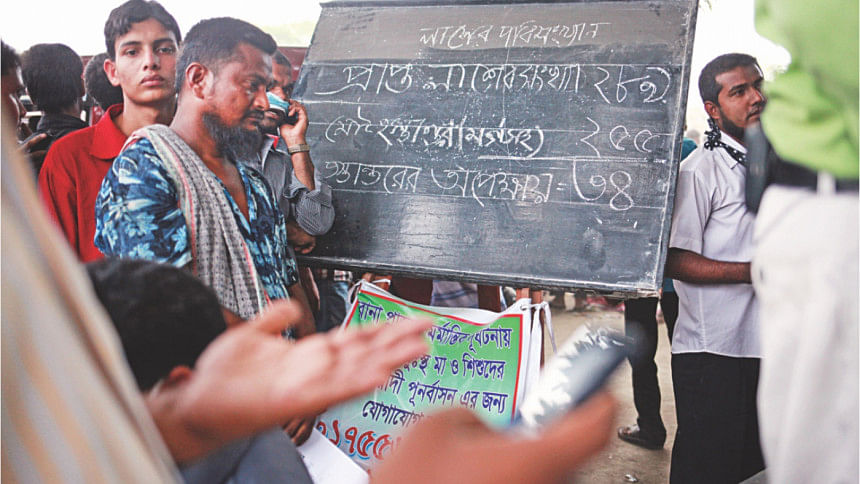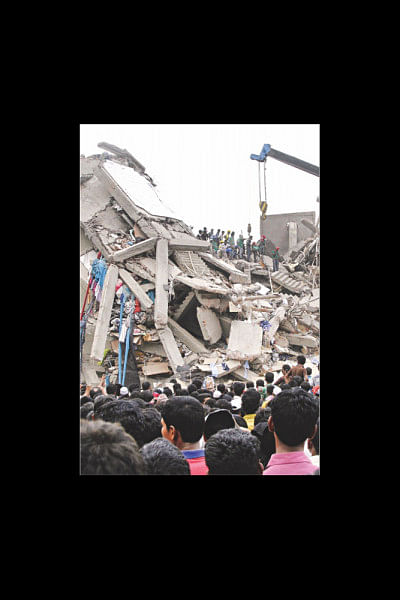Promises and Illusions

April 24, 2016 marks the third anniversary of the collapse of Rana Plaza in Bangladesh, which killed 1,130 garment workers, left thousands seriously wounded - both mentally and physically - and drew international attention to the safety concerns of our garment workers. While their struggle to stand up from the debris of the largest industrial disaster continues, the battle of receiving fair and equitable compensation is also a persistent one.
The question that keeps haunting us, three years after the terrible disaster is: what's the worth of a human life?
According to the International Labour Organisation (ILO) Convention, the Rana Plaza Trust Fund, which collected around $40 million from both the public and private sectors, was formed immediately after the incident. There was also PM's fund, worth Tk. 127 crore, from where only Tk. 22 crore has been disbursed up to last year, leading to much dissatisfaction and frustration among survivors of the collapse, the family of the deceased and the Bangladesh Garment Sramik Sanghati (BGSS).
The varying amount of financial support that they received in the last three years remains a subject of bitter political debate, while the survivors continue to struggle for a normal life and sustainable livelihood.
“The money given to the victims and the families of the deceased by the Rana Plaza Donor Trust Fund came in the form of “donation”, instead of compensation, making the situation more problematic,” says Taslima with disappointment.
While disbursing the funds, a number of factors were taken into account - the physical and psychological trauma of survivors, the urgency of treatment, the number of dependents of those who were killed in the accident, the future potential for survivors in this profession etc.
“The Rana Plaza Agreement Terms and Conditions of Donor Trust Fund does not contain the word compensation, neither does the payment letter by the Rana Plaza Claim Administration, which was issued to the victims. Giving donation in the name of compensation is creating a sense of confusion and dissatisfaction among these victims,” Taslima says.

“Being a humanitarian donation, there is no minimum floor in the amount that the victims have received. Also the disbursement was not done through any strong legal framework, thereby failing to ensure adequate compensation for the victims of factory disasters. As a result, God forbid, if this kind of a disaster shakes the country any time in the future, there will be no legal assurance that the victims would receive a similar amount. Also getting this kind of financial aid will create a sense of dependability in the workers, instead of making them aware of their rights.”
A survey report by ActionAid Bangladesh titled 'Three Years Post Rana Plaza: Challenges in RMG Sector' shows that around 59 percent of the survivors are still traumatised while 48 percent of them remain unemployed due to physical and psychological limitations, despite the passage of time. It is no surprise that survivors, who suffer from psychological trauma following the collapse, did not receive adequate fianancial aid, given that mental health is never taken seriously in our country.
While those who lost limbs or were permanently immobilised due to the collapse received around Tk. 5 to 10 lakhs as compensation, survivors who are saddled with psychological distress (but without any visible physical impairments) received far less, if any, compensation. Khadeja (not her real name) is one such survivor who was stamped under a stampede of workers during the collapse, as they ran down the stairs in their effort to save their lives. This experience left her bruised and injured – both physically and psychologically. How much is enough to compensate her for her wounds? Who is to decide how much compensation each of the survivors receive? And how can Tk. 1,25,000 even be considered as the highest amount of compensation mentioned in the existing Labour Law that we have?
There were promises to reform this law, bringing it in line with international standards. There were promises of long time rehabilitation and health care of the survivors. Three years have passed by, and these pledges are only mirages and illusions that are yet to come true.
But the major question that remains is who is to take the ultimate accountability of compensating these people who have already gone through so much hell? “No matter how much cooperation we get from the global retailers and private sectors, the government and garment factory owners should be the ones taking the major responsibility. If we can make the RMG factory owners pay compensation to the victims, it will act as a lesson for the whole industry and they will be careful from next time onwards,” Taslima says.
Yet another anniversary of this national shame has passed us by; survivors and families of the deceased workers continue to form human chains in the scorching heat, demanding for their compensation, which is their fundamental right.
So what's the worth of a human life? For the victims of the Rana Plaza disaster, it would be nothing, really.

 For all latest news, follow The Daily Star's Google News channel.
For all latest news, follow The Daily Star's Google News channel. 



Comments